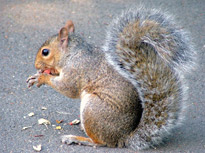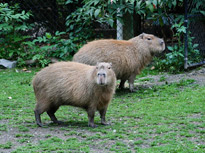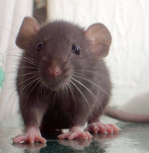Rodentia -- Rats and billions of other gnawers



Origins
This order has by far the largest number of living mammal species. Rodo means "to gnaw" in Latin and these folks are quite wonderfully accomplished at that. There is no place on earth where they are not found except the remote pacific islands(now humans have introduced them there too). We experience these amazing animals as pests because they have adapted quite well to human envelopment of their habitat and have learnt to either ignore us or take advantage of our labors.
True rodents first appear in the fossil record towards the end of the Paleocene epoch. Their ancestry is probably to be found among a group of small fossil mammals known as Anagalids or Mimotonids, which may also have given rise to Rabbits.
The living rodent which most resembles a common ancestor is the sewellel or Mountain Beaver (which is not a true beaver because dam building is not its style) of the northwestern United States. During the Oligocene, when grasslands expanded all over the world the rodents began their great evolutionary radiation. By the Miocene, very modern-looking squirrels had evolved, as had the murids(rats and their cohorts).
What are they like?
Despite their great species diversity, all rodents share common features. They have a single pair of incisors in each jaw, and the incisors grow continually throughout life. The incisors have thick enamel layers on the front but not on the back; this causes them to retain their chisel shape as they are worn down. It also gives them an amazingly sharp bite.
Behind the incisors is a large gap in the tooth rows, or diastema(Remember when your milk teeth were taken by the tooth fairy you had a diastema then too!); there are no canines, and typically only a few molars at the rear of the jaws. Rodents gnaw with their incisors by pushing the lower jaw forward, and chew with the molars by pulling the lower jaw backwards.
Rodents have adapted to all sort of surroundings. Voles live in burrows in he arctic; kangaroo rats live in deserts; capybaras live in the swampy Amazon basin; and common rats live in our homes, fields and even the most bustling of cities.
Geographic Distribution
Rodents are found native on all continents except Antarctica. One particular family of rodents, the Muridae, contains over 1100 species: over a quarter of all mammal species are rats, mice, voles, muskrats, lemmings, hamsters, gerbils, and other members of the Muridae. However, rodents show perhaps their greatest diversity of form in South America, which was an isolated continent for much of the Cenozoic. A few of these distinctive South American rodents include mountain viscachas, rabbit-like forms that inhabit dry mountainous regions; Patagonian cavies, very rabbit-like, fast-running forms with elongated ears and short tails; the coypu or nutria, a large marsh-dwelling rodent that has been introduced into North America and is hunted for its fur; and various burrowing forms such as pacas and tuco-tucos. Other South American rodents include guinea pigs, chinchillas, and New World porcupines (one species of which has dispersed into North America). The capybara (shown at left), yet another South American species, is the largest living rodent. About the size of a pig, and reaching a maximum weight of 50 kg (110 pounds), the capybara is truly a rodent of unusual size. Capybaras live along rivers in the llanos (plains) of South America, and are often hunted or even ranched for their meat.
Reproduction
Pregnancies among rodents are very short, allowing them to spread very quickly accross habitats that they find themselves in. They also provide a mjor food base for all sorts of predators. Every wildlife movie that you have ever seen has some carnivore eating a rodent, guaranteed! In fact, rodent populations are the litmus test of a healthy ecosystem.
In the arctic wolfs and foxes hunt them, in the tropics, numerous cats have them firmly fixed in their sights and the temperate zones provide for birds snacking on them. No wonder then that they have to produce massive amounts of babies for some to survive to adulthood.
Feeding Habits
Rodents need to gnaw so they will use their prodiguous incisors on anything they can find. Many a telephone and electricity cables have so been cut. Usually though, they snack on grass,fruit,seeds and flowers. Some of the families will eat insects,eggs, frogs and fish that they can grab. The family Muridae(Rats & Mice) will try anything edible, including any type of meat they can lay their paws on.
Families within Rodentia
Muridae(Mice & Gerbils)
Myocastoridae(Nutria)
Aplodontiidae(Mountain Beaver)
Diatomyidae(Laotian rock rat)
Petromuridae(Dassie rat)
Pedetidae(Springhares)
Castoridae(Beavers)
Cuniculidae(Pacas)
Dinomyidae(Pacaranas)
Platacanthomyidae(Spiny Dormice)
Anomaluridae(Scaly-tailed squirrels)
Geomyidae(Pocket Gophers)
Heteromyidae(Kangaroo rats & mice)
Ctenodactylidae(Gundis)
Bathyergidae(African mole rats)
Hystricidae(Old World porcupines)
Thryonomyidae(Cane rats)
Heptaxodontidae(Giant Hutias)
Abrocomidae(Chinchilla rats)
Capromyidae(Hutias)
Caviidae(Guinea pigs & capybara)
Chinchillidae(Chinchillas & Viscachas)
Ctenomyidae(Tuco-tucos)
Dasyproctidae(Agoutis)
Echimyidae(Spiny Rats)
Erethizontidae(New World Porcupines)
Octodontidae(Octodonts)
Dipodidae(Jerboas)
Calomyscidae(Mouse-like hamsters)
Cricetidae(Hamsters & Voles)
Nesomyidae(Malagasy Rats)
Spalacidae(Mole rats & Zokors)
Myoxidae(Dormice)
Sciuridae(Squirrels & Marmots)
Videos
Myocastoridae(Nutria)
Aplodontiidae(Mountain Beaver)
Diatomyidae(Laotian rock rat)
Petromuridae(Dassie rat)
Pedetidae(Springhares)
Castoridae(Beavers)
Cuniculidae(Pacas)
Dinomyidae(Pacaranas)
Platacanthomyidae(Spiny Dormice)
Anomaluridae(Scaly-tailed squirrels)
Geomyidae(Pocket Gophers)
Heteromyidae(Kangaroo rats & mice)
Ctenodactylidae(Gundis)
Bathyergidae(African mole rats)
Hystricidae(Old World porcupines)
Thryonomyidae(Cane rats)
Heptaxodontidae(Giant Hutias)
Abrocomidae(Chinchilla rats)
Capromyidae(Hutias)
Caviidae(Guinea pigs & capybara)
Chinchillidae(Chinchillas & Viscachas)
Ctenomyidae(Tuco-tucos)
Dasyproctidae(Agoutis)
Echimyidae(Spiny Rats)
Erethizontidae(New World Porcupines)
Octodontidae(Octodonts)
Dipodidae(Jerboas)
Calomyscidae(Mouse-like hamsters)
Cricetidae(Hamsters & Voles)
Nesomyidae(Malagasy Rats)
Spalacidae(Mole rats & Zokors)
Myoxidae(Dormice)
Sciuridae(Squirrels & Marmots)
Videos
Aplodontiidae(Mountain Beaver)
Diatomyidae(Laotian rock rat)
Petromuridae(Dassie rat)
Pedetidae(Springhares)
Castoridae(Beavers)
Cuniculidae(Pacas)
Dinomyidae(Pacaranas)
Platacanthomyidae(Spiny Dormice)
Anomaluridae(Scaly-tailed squirrels)
Geomyidae(Pocket Gophers)
Heteromyidae(Kangaroo rats & mice)
Ctenodactylidae(Gundis)
Bathyergidae(African mole rats)
Hystricidae(Old World porcupines)
Thryonomyidae(Cane rats)
Heptaxodontidae(Giant Hutias)
Abrocomidae(Chinchilla rats)
Capromyidae(Hutias)
Caviidae(Guinea pigs & capybara)
Chinchillidae(Chinchillas & Viscachas)
Ctenomyidae(Tuco-tucos)
Dasyproctidae(Agoutis)
Echimyidae(Spiny Rats)
Erethizontidae(New World Porcupines)
Octodontidae(Octodonts)
Dipodidae(Jerboas)
Calomyscidae(Mouse-like hamsters)
Cricetidae(Hamsters & Voles)
Nesomyidae(Malagasy Rats)
Spalacidae(Mole rats & Zokors)
Myoxidae(Dormice)
Sciuridae(Squirrels & Marmots)
Videos
Diatomyidae(Laotian rock rat)
Petromuridae(Dassie rat)
Pedetidae(Springhares)
Castoridae(Beavers)
Cuniculidae(Pacas)
Dinomyidae(Pacaranas)
Platacanthomyidae(Spiny Dormice)
Anomaluridae(Scaly-tailed squirrels)
Geomyidae(Pocket Gophers)
Heteromyidae(Kangaroo rats & mice)
Ctenodactylidae(Gundis)
Bathyergidae(African mole rats)
Hystricidae(Old World porcupines)
Thryonomyidae(Cane rats)
Heptaxodontidae(Giant Hutias)
Abrocomidae(Chinchilla rats)
Capromyidae(Hutias)
Caviidae(Guinea pigs & capybara)
Chinchillidae(Chinchillas & Viscachas)
Ctenomyidae(Tuco-tucos)
Dasyproctidae(Agoutis)
Echimyidae(Spiny Rats)
Erethizontidae(New World Porcupines)
Octodontidae(Octodonts)
Dipodidae(Jerboas)
Calomyscidae(Mouse-like hamsters)
Cricetidae(Hamsters & Voles)
Nesomyidae(Malagasy Rats)
Spalacidae(Mole rats & Zokors)
Myoxidae(Dormice)
Sciuridae(Squirrels & Marmots)
Videos
Petromuridae(Dassie rat)
Pedetidae(Springhares)
Castoridae(Beavers)
Cuniculidae(Pacas)
Dinomyidae(Pacaranas)
Platacanthomyidae(Spiny Dormice)
Anomaluridae(Scaly-tailed squirrels)
Geomyidae(Pocket Gophers)
Heteromyidae(Kangaroo rats & mice)
Ctenodactylidae(Gundis)
Bathyergidae(African mole rats)
Hystricidae(Old World porcupines)
Thryonomyidae(Cane rats)
Heptaxodontidae(Giant Hutias)
Abrocomidae(Chinchilla rats)
Capromyidae(Hutias)
Caviidae(Guinea pigs & capybara)
Chinchillidae(Chinchillas & Viscachas)
Ctenomyidae(Tuco-tucos)
Dasyproctidae(Agoutis)
Echimyidae(Spiny Rats)
Erethizontidae(New World Porcupines)
Octodontidae(Octodonts)
Dipodidae(Jerboas)
Calomyscidae(Mouse-like hamsters)
Cricetidae(Hamsters & Voles)
Nesomyidae(Malagasy Rats)
Spalacidae(Mole rats & Zokors)
Myoxidae(Dormice)
Sciuridae(Squirrels & Marmots)
Videos
Pedetidae(Springhares)
Castoridae(Beavers)
Cuniculidae(Pacas)
Dinomyidae(Pacaranas)
Platacanthomyidae(Spiny Dormice)
Anomaluridae(Scaly-tailed squirrels)
Geomyidae(Pocket Gophers)
Heteromyidae(Kangaroo rats & mice)
Ctenodactylidae(Gundis)
Bathyergidae(African mole rats)
Hystricidae(Old World porcupines)
Thryonomyidae(Cane rats)
Heptaxodontidae(Giant Hutias)
Abrocomidae(Chinchilla rats)
Capromyidae(Hutias)
Caviidae(Guinea pigs & capybara)
Chinchillidae(Chinchillas & Viscachas)
Ctenomyidae(Tuco-tucos)
Dasyproctidae(Agoutis)
Echimyidae(Spiny Rats)
Erethizontidae(New World Porcupines)
Octodontidae(Octodonts)
Dipodidae(Jerboas)
Calomyscidae(Mouse-like hamsters)
Cricetidae(Hamsters & Voles)
Nesomyidae(Malagasy Rats)
Spalacidae(Mole rats & Zokors)
Myoxidae(Dormice)
Sciuridae(Squirrels & Marmots)
Videos
Castoridae(Beavers)
Cuniculidae(Pacas)
Dinomyidae(Pacaranas)
Platacanthomyidae(Spiny Dormice)
Anomaluridae(Scaly-tailed squirrels)
Geomyidae(Pocket Gophers)
Heteromyidae(Kangaroo rats & mice)
Ctenodactylidae(Gundis)
Bathyergidae(African mole rats)
Hystricidae(Old World porcupines)
Thryonomyidae(Cane rats)
Heptaxodontidae(Giant Hutias)
Abrocomidae(Chinchilla rats)
Capromyidae(Hutias)
Caviidae(Guinea pigs & capybara)
Chinchillidae(Chinchillas & Viscachas)
Ctenomyidae(Tuco-tucos)
Dasyproctidae(Agoutis)
Echimyidae(Spiny Rats)
Erethizontidae(New World Porcupines)
Octodontidae(Octodonts)
Dipodidae(Jerboas)
Calomyscidae(Mouse-like hamsters)
Cricetidae(Hamsters & Voles)
Nesomyidae(Malagasy Rats)
Spalacidae(Mole rats & Zokors)
Myoxidae(Dormice)
Sciuridae(Squirrels & Marmots)
Videos
Cuniculidae(Pacas)
Dinomyidae(Pacaranas)
Platacanthomyidae(Spiny Dormice)
Anomaluridae(Scaly-tailed squirrels)
Geomyidae(Pocket Gophers)
Heteromyidae(Kangaroo rats & mice)
Ctenodactylidae(Gundis)
Bathyergidae(African mole rats)
Hystricidae(Old World porcupines)
Thryonomyidae(Cane rats)
Heptaxodontidae(Giant Hutias)
Abrocomidae(Chinchilla rats)
Capromyidae(Hutias)
Caviidae(Guinea pigs & capybara)
Chinchillidae(Chinchillas & Viscachas)
Ctenomyidae(Tuco-tucos)
Dasyproctidae(Agoutis)
Echimyidae(Spiny Rats)
Erethizontidae(New World Porcupines)
Octodontidae(Octodonts)
Dipodidae(Jerboas)
Calomyscidae(Mouse-like hamsters)
Cricetidae(Hamsters & Voles)
Nesomyidae(Malagasy Rats)
Spalacidae(Mole rats & Zokors)
Myoxidae(Dormice)
Sciuridae(Squirrels & Marmots)
Videos
Dinomyidae(Pacaranas)
Platacanthomyidae(Spiny Dormice)
Anomaluridae(Scaly-tailed squirrels)
Geomyidae(Pocket Gophers)
Heteromyidae(Kangaroo rats & mice)
Ctenodactylidae(Gundis)
Bathyergidae(African mole rats)
Hystricidae(Old World porcupines)
Thryonomyidae(Cane rats)
Heptaxodontidae(Giant Hutias)
Abrocomidae(Chinchilla rats)
Capromyidae(Hutias)
Caviidae(Guinea pigs & capybara)
Chinchillidae(Chinchillas & Viscachas)
Ctenomyidae(Tuco-tucos)
Dasyproctidae(Agoutis)
Echimyidae(Spiny Rats)
Erethizontidae(New World Porcupines)
Octodontidae(Octodonts)
Dipodidae(Jerboas)
Calomyscidae(Mouse-like hamsters)
Cricetidae(Hamsters & Voles)
Nesomyidae(Malagasy Rats)
Spalacidae(Mole rats & Zokors)
Myoxidae(Dormice)
Sciuridae(Squirrels & Marmots)
Videos
Platacanthomyidae(Spiny Dormice)
Anomaluridae(Scaly-tailed squirrels)
Geomyidae(Pocket Gophers)
Heteromyidae(Kangaroo rats & mice)
Ctenodactylidae(Gundis)
Bathyergidae(African mole rats)
Hystricidae(Old World porcupines)
Thryonomyidae(Cane rats)
Heptaxodontidae(Giant Hutias)
Abrocomidae(Chinchilla rats)
Capromyidae(Hutias)
Caviidae(Guinea pigs & capybara)
Chinchillidae(Chinchillas & Viscachas)
Ctenomyidae(Tuco-tucos)
Dasyproctidae(Agoutis)
Echimyidae(Spiny Rats)
Erethizontidae(New World Porcupines)
Octodontidae(Octodonts)
Dipodidae(Jerboas)
Calomyscidae(Mouse-like hamsters)
Cricetidae(Hamsters & Voles)
Nesomyidae(Malagasy Rats)
Spalacidae(Mole rats & Zokors)
Myoxidae(Dormice)
Sciuridae(Squirrels & Marmots)
Videos
Anomaluridae(Scaly-tailed squirrels)
Geomyidae(Pocket Gophers)
Heteromyidae(Kangaroo rats & mice)
Ctenodactylidae(Gundis)
Bathyergidae(African mole rats)
Hystricidae(Old World porcupines)
Thryonomyidae(Cane rats)
Heptaxodontidae(Giant Hutias)
Abrocomidae(Chinchilla rats)
Capromyidae(Hutias)
Caviidae(Guinea pigs & capybara)
Chinchillidae(Chinchillas & Viscachas)
Ctenomyidae(Tuco-tucos)
Dasyproctidae(Agoutis)
Echimyidae(Spiny Rats)
Erethizontidae(New World Porcupines)
Octodontidae(Octodonts)
Dipodidae(Jerboas)
Calomyscidae(Mouse-like hamsters)
Cricetidae(Hamsters & Voles)
Nesomyidae(Malagasy Rats)
Spalacidae(Mole rats & Zokors)
Myoxidae(Dormice)
Sciuridae(Squirrels & Marmots)
Videos
Geomyidae(Pocket Gophers)
Heteromyidae(Kangaroo rats & mice)
Ctenodactylidae(Gundis)
Bathyergidae(African mole rats)
Hystricidae(Old World porcupines)
Thryonomyidae(Cane rats)
Heptaxodontidae(Giant Hutias)
Abrocomidae(Chinchilla rats)
Capromyidae(Hutias)
Caviidae(Guinea pigs & capybara)
Chinchillidae(Chinchillas & Viscachas)
Ctenomyidae(Tuco-tucos)
Dasyproctidae(Agoutis)
Echimyidae(Spiny Rats)
Erethizontidae(New World Porcupines)
Octodontidae(Octodonts)
Dipodidae(Jerboas)
Calomyscidae(Mouse-like hamsters)
Cricetidae(Hamsters & Voles)
Nesomyidae(Malagasy Rats)
Spalacidae(Mole rats & Zokors)
Myoxidae(Dormice)
Sciuridae(Squirrels & Marmots)
Videos
Heteromyidae(Kangaroo rats & mice)
Ctenodactylidae(Gundis)
Bathyergidae(African mole rats)
Hystricidae(Old World porcupines)
Thryonomyidae(Cane rats)
Heptaxodontidae(Giant Hutias)
Abrocomidae(Chinchilla rats)
Capromyidae(Hutias)
Caviidae(Guinea pigs & capybara)
Chinchillidae(Chinchillas & Viscachas)
Ctenomyidae(Tuco-tucos)
Dasyproctidae(Agoutis)
Echimyidae(Spiny Rats)
Erethizontidae(New World Porcupines)
Octodontidae(Octodonts)
Dipodidae(Jerboas)
Calomyscidae(Mouse-like hamsters)
Cricetidae(Hamsters & Voles)
Nesomyidae(Malagasy Rats)
Spalacidae(Mole rats & Zokors)
Myoxidae(Dormice)
Sciuridae(Squirrels & Marmots)
Videos
Ctenodactylidae(Gundis)
Bathyergidae(African mole rats)
Hystricidae(Old World porcupines)
Thryonomyidae(Cane rats)
Heptaxodontidae(Giant Hutias)
Abrocomidae(Chinchilla rats)
Capromyidae(Hutias)
Caviidae(Guinea pigs & capybara)
Chinchillidae(Chinchillas & Viscachas)
Ctenomyidae(Tuco-tucos)
Dasyproctidae(Agoutis)
Echimyidae(Spiny Rats)
Erethizontidae(New World Porcupines)
Octodontidae(Octodonts)
Dipodidae(Jerboas)
Calomyscidae(Mouse-like hamsters)
Cricetidae(Hamsters & Voles)
Nesomyidae(Malagasy Rats)
Spalacidae(Mole rats & Zokors)
Myoxidae(Dormice)
Sciuridae(Squirrels & Marmots)
Videos
Bathyergidae(African mole rats)
Hystricidae(Old World porcupines)
Thryonomyidae(Cane rats)
Heptaxodontidae(Giant Hutias)
Abrocomidae(Chinchilla rats)
Capromyidae(Hutias)
Caviidae(Guinea pigs & capybara)
Chinchillidae(Chinchillas & Viscachas)
Ctenomyidae(Tuco-tucos)
Dasyproctidae(Agoutis)
Echimyidae(Spiny Rats)
Erethizontidae(New World Porcupines)
Octodontidae(Octodonts)
Dipodidae(Jerboas)
Calomyscidae(Mouse-like hamsters)
Cricetidae(Hamsters & Voles)
Nesomyidae(Malagasy Rats)
Spalacidae(Mole rats & Zokors)
Myoxidae(Dormice)
Sciuridae(Squirrels & Marmots)
Videos
Hystricidae(Old World porcupines)
Thryonomyidae(Cane rats)
Heptaxodontidae(Giant Hutias)
Abrocomidae(Chinchilla rats)
Capromyidae(Hutias)
Caviidae(Guinea pigs & capybara)
Chinchillidae(Chinchillas & Viscachas)
Ctenomyidae(Tuco-tucos)
Dasyproctidae(Agoutis)
Echimyidae(Spiny Rats)
Erethizontidae(New World Porcupines)
Octodontidae(Octodonts)
Dipodidae(Jerboas)
Calomyscidae(Mouse-like hamsters)
Cricetidae(Hamsters & Voles)
Nesomyidae(Malagasy Rats)
Spalacidae(Mole rats & Zokors)
Myoxidae(Dormice)
Sciuridae(Squirrels & Marmots)
Videos
Thryonomyidae(Cane rats)
Heptaxodontidae(Giant Hutias)
Abrocomidae(Chinchilla rats)
Capromyidae(Hutias)
Caviidae(Guinea pigs & capybara)
Chinchillidae(Chinchillas & Viscachas)
Ctenomyidae(Tuco-tucos)
Dasyproctidae(Agoutis)
Echimyidae(Spiny Rats)
Erethizontidae(New World Porcupines)
Octodontidae(Octodonts)
Dipodidae(Jerboas)
Calomyscidae(Mouse-like hamsters)
Cricetidae(Hamsters & Voles)
Nesomyidae(Malagasy Rats)
Spalacidae(Mole rats & Zokors)
Myoxidae(Dormice)
Sciuridae(Squirrels & Marmots)
Videos
Heptaxodontidae(Giant Hutias)
Abrocomidae(Chinchilla rats)
Capromyidae(Hutias)
Caviidae(Guinea pigs & capybara)
Chinchillidae(Chinchillas & Viscachas)
Ctenomyidae(Tuco-tucos)
Dasyproctidae(Agoutis)
Echimyidae(Spiny Rats)
Erethizontidae(New World Porcupines)
Octodontidae(Octodonts)
Dipodidae(Jerboas)
Calomyscidae(Mouse-like hamsters)
Cricetidae(Hamsters & Voles)
Nesomyidae(Malagasy Rats)
Spalacidae(Mole rats & Zokors)
Myoxidae(Dormice)
Sciuridae(Squirrels & Marmots)
Videos
Abrocomidae(Chinchilla rats)
Capromyidae(Hutias)
Caviidae(Guinea pigs & capybara)
Chinchillidae(Chinchillas & Viscachas)
Ctenomyidae(Tuco-tucos)
Dasyproctidae(Agoutis)
Echimyidae(Spiny Rats)
Erethizontidae(New World Porcupines)
Octodontidae(Octodonts)
Dipodidae(Jerboas)
Calomyscidae(Mouse-like hamsters)
Cricetidae(Hamsters & Voles)
Nesomyidae(Malagasy Rats)
Spalacidae(Mole rats & Zokors)
Myoxidae(Dormice)
Sciuridae(Squirrels & Marmots)
Videos
Capromyidae(Hutias)
Caviidae(Guinea pigs & capybara)
Chinchillidae(Chinchillas & Viscachas)
Ctenomyidae(Tuco-tucos)
Dasyproctidae(Agoutis)
Echimyidae(Spiny Rats)
Erethizontidae(New World Porcupines)
Octodontidae(Octodonts)
Dipodidae(Jerboas)
Calomyscidae(Mouse-like hamsters)
Cricetidae(Hamsters & Voles)
Nesomyidae(Malagasy Rats)
Spalacidae(Mole rats & Zokors)
Myoxidae(Dormice)
Sciuridae(Squirrels & Marmots)
Videos
Caviidae(Guinea pigs & capybara)
Chinchillidae(Chinchillas & Viscachas)
Ctenomyidae(Tuco-tucos)
Dasyproctidae(Agoutis)
Echimyidae(Spiny Rats)
Erethizontidae(New World Porcupines)
Octodontidae(Octodonts)
Dipodidae(Jerboas)
Calomyscidae(Mouse-like hamsters)
Cricetidae(Hamsters & Voles)
Nesomyidae(Malagasy Rats)
Spalacidae(Mole rats & Zokors)
Myoxidae(Dormice)
Sciuridae(Squirrels & Marmots)
Videos
Chinchillidae(Chinchillas & Viscachas)
Ctenomyidae(Tuco-tucos)
Dasyproctidae(Agoutis)
Echimyidae(Spiny Rats)
Erethizontidae(New World Porcupines)
Octodontidae(Octodonts)
Dipodidae(Jerboas)
Calomyscidae(Mouse-like hamsters)
Cricetidae(Hamsters & Voles)
Nesomyidae(Malagasy Rats)
Spalacidae(Mole rats & Zokors)
Myoxidae(Dormice)
Sciuridae(Squirrels & Marmots)
Videos
Ctenomyidae(Tuco-tucos)
Dasyproctidae(Agoutis)
Echimyidae(Spiny Rats)
Erethizontidae(New World Porcupines)
Octodontidae(Octodonts)
Dipodidae(Jerboas)
Calomyscidae(Mouse-like hamsters)
Cricetidae(Hamsters & Voles)
Nesomyidae(Malagasy Rats)
Spalacidae(Mole rats & Zokors)
Myoxidae(Dormice)
Sciuridae(Squirrels & Marmots)
Videos
Dasyproctidae(Agoutis)
Echimyidae(Spiny Rats)
Erethizontidae(New World Porcupines)
Octodontidae(Octodonts)
Dipodidae(Jerboas)
Calomyscidae(Mouse-like hamsters)
Cricetidae(Hamsters & Voles)
Nesomyidae(Malagasy Rats)
Spalacidae(Mole rats & Zokors)
Myoxidae(Dormice)
Sciuridae(Squirrels & Marmots)
Videos
Echimyidae(Spiny Rats)
Erethizontidae(New World Porcupines)
Octodontidae(Octodonts)
Dipodidae(Jerboas)
Calomyscidae(Mouse-like hamsters)
Cricetidae(Hamsters & Voles)
Nesomyidae(Malagasy Rats)
Spalacidae(Mole rats & Zokors)
Myoxidae(Dormice)
Sciuridae(Squirrels & Marmots)
Videos
Erethizontidae(New World Porcupines)
Octodontidae(Octodonts)
Dipodidae(Jerboas)
Calomyscidae(Mouse-like hamsters)
Cricetidae(Hamsters & Voles)
Nesomyidae(Malagasy Rats)
Spalacidae(Mole rats & Zokors)
Myoxidae(Dormice)
Sciuridae(Squirrels & Marmots)
Videos
Octodontidae(Octodonts)
Dipodidae(Jerboas)
Calomyscidae(Mouse-like hamsters)
Cricetidae(Hamsters & Voles)
Nesomyidae(Malagasy Rats)
Spalacidae(Mole rats & Zokors)
Myoxidae(Dormice)
Sciuridae(Squirrels & Marmots)
Videos
Dipodidae(Jerboas)
Calomyscidae(Mouse-like hamsters)
Cricetidae(Hamsters & Voles)
Nesomyidae(Malagasy Rats)
Spalacidae(Mole rats & Zokors)
Myoxidae(Dormice)
Sciuridae(Squirrels & Marmots)
Videos
Calomyscidae(Mouse-like hamsters)
Cricetidae(Hamsters & Voles)
Nesomyidae(Malagasy Rats)
Spalacidae(Mole rats & Zokors)
Myoxidae(Dormice)
Sciuridae(Squirrels & Marmots)
Videos
Cricetidae(Hamsters & Voles)
Nesomyidae(Malagasy Rats)
Spalacidae(Mole rats & Zokors)
Myoxidae(Dormice)
Sciuridae(Squirrels & Marmots)
Videos
Nesomyidae(Malagasy Rats)
Spalacidae(Mole rats & Zokors)
Myoxidae(Dormice)
Sciuridae(Squirrels & Marmots)
Videos
Spalacidae(Mole rats & Zokors)
Myoxidae(Dormice)
Sciuridae(Squirrels & Marmots)
Videos
Myoxidae(Dormice)
Sciuridae(Squirrels & Marmots)
Videos
Sciuridae(Squirrels & Marmots)
Videos
Videos
References
The Department of Paleantology at UC Berkeley
Wikipedia
Origin of Rodents
The Princeton Encyclopedia of Mammals